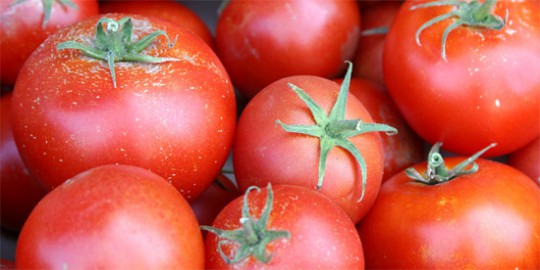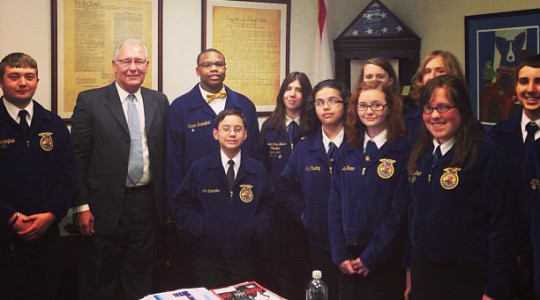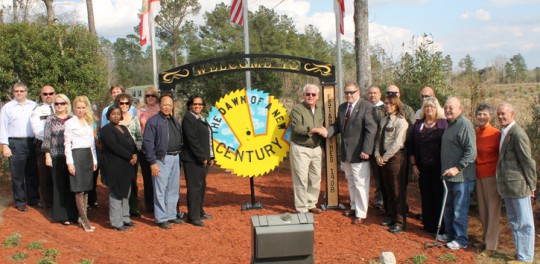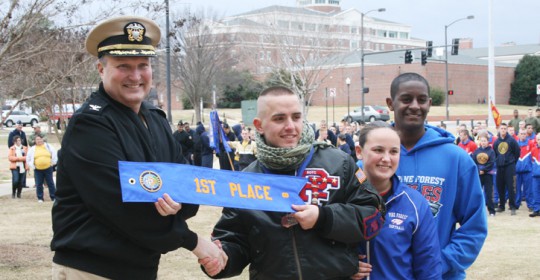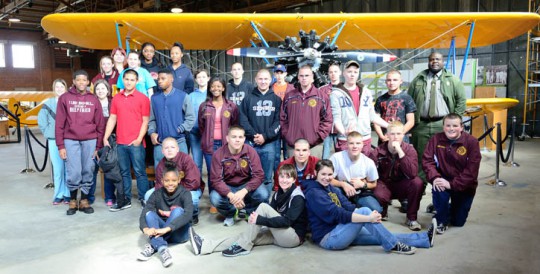Weekend Gardening: Choosing Heirloom Or Hybrid Tomatoes
March 16, 2013
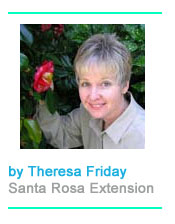 Tomatoes are a favorite of backyard gardeners. Fresh-grown tomatoes are packed with flavor and nutrition. Due to their popularity, many different types of tomatoes have been developed and selected over time. Choosing the best type for your individual growing situation will increase your chance of enjoying a mouth-watering tomato sandwich on a hot summer day.
Tomatoes are a favorite of backyard gardeners. Fresh-grown tomatoes are packed with flavor and nutrition. Due to their popularity, many different types of tomatoes have been developed and selected over time. Choosing the best type for your individual growing situation will increase your chance of enjoying a mouth-watering tomato sandwich on a hot summer day.
Heirloom vegetables are back in vogue. A tomato must meet three criteria to be considered an heirloom variety. The variety must grow “true to type” from seed saved from each fruit, the seed must have been available for more than 50 years and the variety must have a history or folklore of its own. Heirloom vegetables are also called open-pollinated or non-hybrid.
Heirloom tomatoes are known for their full flavor and excellent taste. Gardeners who start their plants from seeds have always had many choices available to them. This year, I was surprised to see some heirloom seedlings in stores including ‘Cherokee Purple.’ This is an heirloom from Tennessee rumored to have come from Cherokee gardeners. Its rich flavor is said to be similar to the much-celebrated Brandywine.
While heirlooms offer better flavor, they do have a downside. Their biggest weakness is that they are not generally disease resistant and therefore more susceptible to devastating and sometimes fatal diseases. Heirloom varieties also experience more fruit defects such as cracking and catfacing.
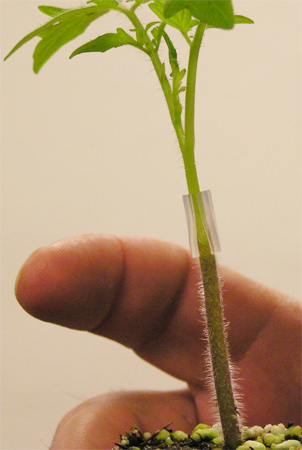 To overcome the potential disease pitfall of heirloom varieties, many gardeners are now grafting their tomato seedlings. In the case of heirloom tomatoes, grafting involves connecting the shoot of the heirloom variety to the roots of a disease-resistant rootstock. The cut pieces are held together by a grafting clip until the tissues grow together (pictured left).
To overcome the potential disease pitfall of heirloom varieties, many gardeners are now grafting their tomato seedlings. In the case of heirloom tomatoes, grafting involves connecting the shoot of the heirloom variety to the roots of a disease-resistant rootstock. The cut pieces are held together by a grafting clip until the tissues grow together (pictured left).
To learn more about heirloom tomatoes and grafting, read the UF/IFAS publication entitled, “Growing Heirloom Tomato Varieties in Southwest Florida.” It’s available online at http://edis.ifas.ufl.edu/hs174 or by calling your local Extension Office.
Hybrid tomatoes are those that have been breed and selected for their disease resistance and productivity. They are the first-generation cross between two “pure” parental lines.
The simplest way to define an F-1 hybrid is to take an example. Let’s say a plant breeder observes a particularly good growth-habit in a plant, but with poor flower color, and in another plant of the same type they see good color but poor habit. The best plant of each type is taken and self-pollinated (in isolation) each year and, each year, the seed is re-sown. Eventually, every time the seed is sown the same identical plants will appear. This is known as a ‘pure line.’
If the breeder then takes the pure line of each of the two plants they originally selected and cross pollinates the two by hand the result is known as an F-1 hybrid. Plants are grown from seed produced and the result of this cross pollination should have a good habit and good color.
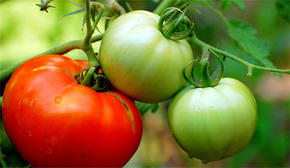 The vigor of hybridization can increase yields, improve pest resistance and impart other desirable characteristics. Some have credited crop hybridization as a prime reason for our country’s ability to feed larger populations with fewer farmers.
The vigor of hybridization can increase yields, improve pest resistance and impart other desirable characteristics. Some have credited crop hybridization as a prime reason for our country’s ability to feed larger populations with fewer farmers.
A down side of hybridization is that if you collect and save the seed from a hybrid variety, its offspring will show a loss of that hybrid vigor – it will start to revert back to its inbred parents. If you want the vigorous capacity that comes with hybrid varieties; don’t save the seed for replanting. You will have to buy new seed each year.
To learn about tomato varieties recommended for Florida gardens, read the UF/IFAS publication entitled “Tomatoes in the Florida Garden.” It’s available online at http://edis.ifas.ufl.edu/vh028 or by calling your local Extension Office.
Theresa Friday is the Residential Horticulture Extension Agent for Santa Rosa County.
Emeril Lagasse Show Sunday To Feature Pensacola On The Cooking Channel
March 15, 2013
 On Sunday, celebrity chef Emeril Lagasse will feature restaurants in Pensacola on his Cooking Channel show Emeril’s Florida.
On Sunday, celebrity chef Emeril Lagasse will feature restaurants in Pensacola on his Cooking Channel show Emeril’s Florida.
“This unique series, hosted by Chef Emeril, gives viewers the chance to experience some of the best food Florida has to offer,” said Carol Dover, president and CEO of the Florida Restaurant and Lodging Association. “We believe this show will motivate people across the country to visit Florida and taste the state’s vibrant flavors at our wonderful restaurants.”
Emeril begins this week’s show at McGuire’s Irish Pub in Pensacola. He then heads to The Fish House restaurant and samples their various dishes. At Joe Patti’s Seafood, Frank Patti gives him a tour and shares tips on buying fish. Finally, Emeril and his son EJ head to Pensacola Beach, taking a ride on the observation wheel as well as sampling local seafood.
“He was very nice; he was in front of me getting some Beignets,” said Felicia Amerson of Walnut Hill. Amerson and her husband Alex bumped into Lagasse at Joe Patti’s as he filmed his show back in October. “He turned around, and I said ‘OMG’ I’m your biggest fan, can I have a picture with you. He said sure we gotta hurry cause I’ve got a lot of work to do.”
The show airs Sunday, March 17th, at 9:30 a.m. on the Cooking Channel, and again on Monday, March 18th, at 8:30 a.m.
Pictured: Felicia Amerson of Walnut Hill posses with chef Emeril Lagasse back in October at Joe Patti’s Seafood in Pensacola as he filmed a segment for his show that will air Sunday on the Cooking Channel. Submitted photo for NorthEscambia.com, click to enlarge.
Northview, West Florida, Ernest Ward FFA Members Attend Ag On The Hill
March 13, 2013
Students from the FFA chapters at Northview High, West Florida High and Ernest Ward Middle schools attended the annual “Ag On the Hill” event Tuesday in Tallahassee. The local FFA members were able to visit with state leaders, including Sen. Greg Evers (pictured above), Rep. Clay Ingram and Commission of Agriculture Adam Putnam. Ag on the Hill is presented annually by the Florida Association of Agricultural Educators, The University of Florida and the Florida Department of Agriculture and Consumer Services. Courtesy photo for NorthEscambia.com, click to enlarge.
Century Correctional Receives ‘Community Pride’ Award
March 13, 2013
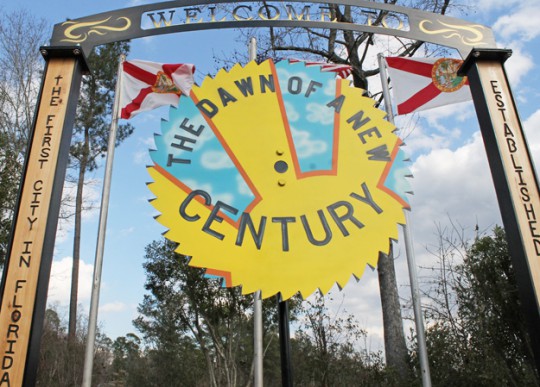 The Century Chamber of Commerce’s Community Pride Award for March has been presented to the Century Correctional Institution.
The Century Chamber of Commerce’s Community Pride Award for March has been presented to the Century Correctional Institution.
CCI, the largest employer in Century, recently installed new “Welcome to Century” alongside Highway 29 at the northern and southern boundaries of the town. The “Welcome to Century” signs were designed by Lt. Tony Nolen of CCI and built with inmate labor. The signs celebrate the town’s sawmill heritage.
Pictured: New “Welcome to Century” signs constructed with inmate labor from Century Correctional Institution were dedicated in late January. NorthEscambia.com photos, click to enlarge.
Save Over Half On Groceries? Learn To Be A Coupon Queen (Or King)
March 12, 2013
 Area residents can learn to be a coupon queens (or kings) at a class this weekend in McDavid.
Area residents can learn to be a coupon queens (or kings) at a class this weekend in McDavid.
“I have been couponing for years,” said Science of Couponing Class teacher Candace Capps. “I am no extreme couponer but have saved normally between 60 and 70 percent on my stuff.”
The class will be held from 10 a.m. until 1 p.m. on Saturday at Rays Chapel Baptist Church. The cost is $10 per person, with childcare available for $5. Proceeds benefit church mission trips.
For more details or to sign up, call Candace Capps at (850) 554-0683 or register on Facebook.
Pictured: Science of Couponing Class teacher Candace Capps saved $159.60 – almost 70 percent — on a recent grocery shopping trip. Submitted photos for NorthEscambia.com, click to enlarge.
Pine Forest NJROTC Places First In Area Drill Meet
March 11, 2013
- 1st Place Individual Academic, c/CDR Robert Rudd
- 1st Place Individual Male Sit Ups (193), c/CDR Robert Rudd
- 3rd Place Individual Male Sit Ups, Joseph Kaiser
- 2nd Place Push Up Team
- 1st Place Sit Up Team
- 2nd Place Personnel Inspection
- 3rd Place Academic Team
- 1st Place Armed Basic Drill
- 1st Place Unarmed Basic Drill
- 3rd Place Color Guard
- 1st Place Overall
The team will travel to Ole Miss for the Area8 NJROTC Super Meet on March 23. Finishing in the top will earn the team their fifth appearance in six years at the NJROTC National Drill, PT and Academic meet to be held in April aboard NAS Pensacola.
Photo courtesy Lori Rudd for NorthEscambia.com, click to enlarge.
Weekend Gardening: Caring For Camellias
March 10, 2013
One of Northwest Florida’s most reliable and rewarding shrubs is the camellia. Providing dark green leaves throughout the year, gardeners are rewarded in late winter or early spring with a variety of beautifully colored and shaped flowers. Camellias tend to thrive in our acidic soil but they do require some routine maintenance.
 Pick up the fallen flowers. A fungal disease known as petal blight will rapidly turn entire flowers brown. If a camellia has petal blight, remove and dispose of all blighted flowers both on the plant and on the ground. You may also consider discarding the old mulch around the shrub and apply a layer of fresh mulch. This practice sometimes helps prevent fungal spores from blowing back onto new flowers. One of the best ways to prevent this disease is to pick up and destroy fallen blooms. Flowers will continue to drop for several weeks, so it’s important to pick up blooms several times a week.
Pick up the fallen flowers. A fungal disease known as petal blight will rapidly turn entire flowers brown. If a camellia has petal blight, remove and dispose of all blighted flowers both on the plant and on the ground. You may also consider discarding the old mulch around the shrub and apply a layer of fresh mulch. This practice sometimes helps prevent fungal spores from blowing back onto new flowers. One of the best ways to prevent this disease is to pick up and destroy fallen blooms. Flowers will continue to drop for several weeks, so it’s important to pick up blooms several times a week.
Scout for tea scale. One of the most common insect pests of camellia is a scale insect known as tea scale. Check the underside of leaves regularly for this annoying pest. These small, sessile, white, thin, sap-sucking insects can build up large numbers if you do not regularly inspect your plants and take corrective measures when scale is first found. Often your first clue will be spotty yellowing on the upper surface of the leaves. Horticultural oil can be used in the winter time if used before blooming or in spring after blooming. Do not apply horticultural oil when near-freezing temperatures may be expected. Always carefully read and follow pesticide label directions before use.
Expect some leaves to fall in the spring. Camellias are “evergreen” meaning that they have leaves on the shrub year round. However, as individual leaves age, they will fall from the shrub and are replaced with new leaves in the spring. It is not unusual for camellia to drop up to 30 percent of their leaves. As long as new leaves are developing, there is no need for concern.
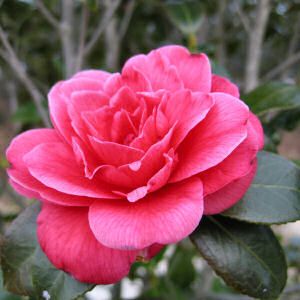 Camellia can be pruned after they flower. The most important reason for pruning camellias is to improve the overall health of the plant. Many times, camellias that have not been pruned in a few years will develop dead or deteriorating twigs. Removing the dead and dying limbs will minimize the possibility of diseases such as “dieback” and will also allow the plant to re-concentrate its energies. In many instances, camellias that have been neglected for a number of years will become infested with scale insects. Pruning is an effective way to provide for better coverage of chemical sprays and increase air circulation.
Camellia can be pruned after they flower. The most important reason for pruning camellias is to improve the overall health of the plant. Many times, camellias that have not been pruned in a few years will develop dead or deteriorating twigs. Removing the dead and dying limbs will minimize the possibility of diseases such as “dieback” and will also allow the plant to re-concentrate its energies. In many instances, camellias that have been neglected for a number of years will become infested with scale insects. Pruning is an effective way to provide for better coverage of chemical sprays and increase air circulation.
Lichens are warning signs. Lichens are gray-green to green mossy growths on the stems of old, neglected camellias. The lichen is a combination of a fungus and an alga that grows symbiotically. They are not parasitic to the camellia. Affected plants usually need fertilizing, watering, and mulching for better growing conditions.
Fertilizer applications help to achieve maximum performance. Apply fertilizer in the spring after blooming but before new growth starts. With many fertilizers, small amounts at frequent intervals are better than heavy applications. Special camellia fertilizers are available at your local stores. One application in early spring after blooming should be followed by a second application in mid June to early July. Scatter the fertilizer evenly on top of the mulch and away from the main stem of the plant. Water the fertilizer into the soil. Do not fertilize after July, so the plants will have a longer time to harden off and avoid freeze damage.
Theresa Friday is the Residential Horticulture Extension Agent for Santa Rosa County.
Spring Fling Festival Today In Molino
March 9, 2013
The annual CrossFaith Church Spring Fling Festival is today.
The event will feature live music, craft vendors and more. There will be free children’s activities including horse rides, petting zoo, inflatable and face painting. Fish fry dinners will be $6, plus there will be hot dogs desserts and drinks available.
The event takes place from 9 a.m. until 3 p.m. at 5701 Highway 29 in Molino. For more information, call (850) 587-3187.
Photos: Ernest Ward Holds Womanless Beauty Pageant
March 9, 2013
 Hunter Edwards was named Junior Mr. Miss Ernest Ward Middle School in a womanless beauty pageant Friday night. First runner-up was Jacob Weaver, and second runner-up was Luke Ward. Edwards also received the audience vote People’s Choice Award.
Hunter Edwards was named Junior Mr. Miss Ernest Ward Middle School in a womanless beauty pageant Friday night. First runner-up was Jacob Weaver, and second runner-up was Luke Ward. Edwards also received the audience vote People’s Choice Award.
For a photo gallery, click here.
Proceeds from the even will benefit the school’s cheerleaders.
Pictured top: Luke Ward and and Hunter Edwards (right) compete in a womanless beauty pageant Friday night at Ernest Ward Middle School. Pictured left inset: Hunter Edwards was crowned Junior Mr. Miss Ernest Ward Middle School. NorthEscambia.com photos, click to enlarge.
NHS NJROTC Takes Part In Auburn Drill Meet
March 8, 2013
 Northview High School’s NJROTC recently competed in a drill meet at Auburn University, finishing fourth overall against 12 schools from Florida, Georgia, Mississippi and Louisiana.
Northview High School’s NJROTC recently competed in a drill meet at Auburn University, finishing fourth overall against 12 schools from Florida, Georgia, Mississippi and Louisiana.
The unit competed in multiple events which included a personnel inspection, academic test, basic drill and physical fitness.
“The outstanding results by the unit was the culmination of a lot of hard work over the past several weeks by each cadet that competed. The competition is always tough at these meets but the cadets were focused and determined to succeed. As always they were great representatives of Northview and the community,” said Charlie C. Code, Capt USN (ret), Northview instructor.
The unit also toured the Auburn campus and the nearby Tuskegee Airman Museum.
Submitted photos for NorthEscambia.com, click to enlarge.


